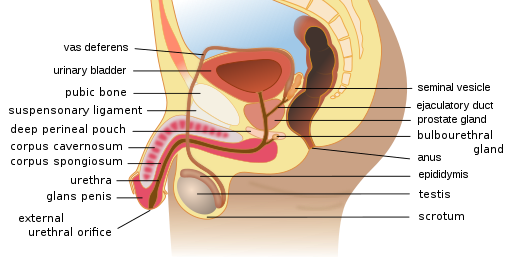6.6 Male Reproductive System
Overview and Functions
The function of the male reproductive system is to produce the sperm, which can then be transferred to the female reproductive tract. The testes are a critical component of the system because they produce both the sperm and the hormones that support all the male reproductive physiology. There are other accessory organs that assist with the production of sperm and seminal components that are also needed in the process. They include the epididymis, vas deferens, prostate, seminal vesicles, and the penis.

(CrashCourse, 2015)
Components of the Male Reproductive System
Scrotum: The scrotum is a skin-covered, highly pigmented, muscular sac that encloses the testes. The location of the scrotum behind the base of the penis is important in sperm production, which occurs in the testes. Sperm production cannot occur at body temperature, and the location of the scrotum outside the body keeps the testes 2 to 4°C below core body temperature.
Testes: These are the male gonads or, in other words, the male reproductive organs. The testes produce sperm and androgens such as testosterone. The singular form of testes is testis.
Epididymis: This is a coiled tube attached to each testis. Newly formed sperm travel down the epididymis as they continue to mature, a journey that on average takes 12 days, and the mature sperm are stored in the tail end of the epididymis.
Vas deferens: This thick, muscular tube is bundled together inside the scrotum with connective tissue, blood vessels, and nerves. It is also known as the ductus deferens and transports sperm from the epididymis to the urethra.
Seminal vesicles: As sperm pass through the vas deferens, they mix with fructose fluid from the seminal vesicles. The fluid accounts for approximately 60% of the semen’s volume.
Prostate gland: This gland sits in front of the rectum and at the base of the bladder, surrounding part of the urethra. The prostrate is about the size of a walnut and excretes an alkaline, milky fluid into the semen, which assists with transportation to the female reproductive tract.
Bulbourethral glands: These glands release a thick, salty fluid that lubricates the end of the urethra and helps clean urine residue from the male urethra (Carter & Rutherford, 2020).
Penis: This is the male organ of copulation and deposits semen into the female reproductive tract.
Combining Forms
Table 6.5. Combining Forms
| COMBINING FORM | MEANING | EXAMPLE OF USE IN MEDICAL TERMS |
|---|---|---|
| balan/o | penis | balanitis |
| orch/o | testis | orchitis |
| orchi/o | testis | orchioplasty |
| orchid/o | testis | orchidotomy |
| prostat/o | prostate gland | prostatectomy |
| scrot/o | scrotum | scrotitis |
| urethr/o | urethra | urethrotomy |
| vas/o | vas deferens | vasectomy |
Common Pathologies
Benign prostatic hyperplasia/hypertrophy (BPH): This condition is characterized by an increase in the size of the prostate. Individuals typically present with difficulty urinating. It can be treated with medication or a procedure such as a transurethral resection of the prostate (TURP).
Cryptorchidism: This occurs when one or both of the testes do not descend into the scrotum prior to birth. The testes usually move into the scrotal cavity during the seventh month of development of a male fetus.
Hydrocele: This is an accumulation of fluid within the scrotum and can be treated surgically. In some cases, this pathology corrects itself without treatment.
Prostate cancer: Malignant cancer present within the prostate gland (Carter & Rutherford, 2020).
Sexually transmitted infections (STIs): This is a general term for infections that are spread through sexual contact between individuals. There are various types of STIs, but a couple of the more common ones are chlamydia and gonorrhea (Carter & Rutherford, 2020).
Varicocele: An enlarged or swollen vein in the scrotum.
Exercise
Attribution
Unless otherwise indicated, material on this page has been adapted from the following resource:
Betts, J. G., Young, K. A., Wise, J. A., Johnson, E., Poe, B., Kruse, D. H., Korol, O., Johnson, J. E., Womble, M., & DeSaix, P. (2013). Anatomy and physiology. OpenStax. https://openstax.org/details/books/anatomy-and-physiology licensed under CC BY 4.0
References
Carter, K., & Rutherford, M. (2020). Building a medical terminology foundation. eCampusOntario. https://ecampusontario.pressbooks.pub/medicalterminology/ licensed under CC BY 4.0
CrashCourse. (2015, November 9). Reproductive system, part 2 – Male reproductive system: Crash Course A&P 41 [Video]. YouTube. https://www.youtube.com/watch?v=-XQcnO4iX_Uh
Image Credits (images are listed in order of appearance)
Inflammation of the penis
Inflammation of the testis
Surgical repair of the testes
An incision into the testis
Surgical removal of part or all of the prostate
Inflammation of the scrotum
An incision into the urethra
A surgical procedure for male sterilization

